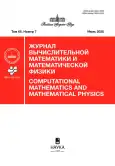卷 65, 编号 7 (2025)
K 70-letiyu E.E. Tyrtyshnikova
 1059
1059


General numerical methods
Eigenvalues of non-Hermitian banded Toeplitz matrices approaching simple points of the limiting set
摘要
For large non-Hermitian banded Toeplitz matrices, it is well known that their eigenvalues cluster along a limiting set, which is formed by a finite union of closed analytic arcs. We consider general non-Hermitian banded Toeplitz matrices and extend the simple-loop method to obtain individual asymptotic expansions for eigenvalues approaching simple and non-degenerate points of the limiting set as the matrix order increases to infinity. We also develop an algorithm to effectively compute these expansions.
 1060-1076
1060-1076


Tensor cross interpolation for global discrete optimization with application to Bayesian network inference
摘要
Global discrete optimization is notoriously difficult due to the lack of gradient information and the curse of dimensionality, making exhaustive search infeasible. Tensor cross approximation is an efficient technique to approximate multivariate tensors (and discretized functions) by tensor product decompositions based on a small number of tensor elements, evaluated on adaptively selected fibers of the tensor, that intersect on submatrices of (nearly) maximum volume. The submatrices of maximum volume are empirically known to contain large elements, hence the entries selected for cross interpolation can also be good candidates for the globally maximal element within the tensor. In this paper we consider evolution of epidemics on networks, and infer the contact network from observations of network nodal states over time. By numerical experiments we demonstrate that the contact network can be inferred accurately by finding the global maximum of the likelihood using tensor cross interpolation. The proposed tensor product approach is flexible and can be applied to global discrete optimization for other problems, e.g. discrete hyperparameter tuning.
 1077-1090
1077-1090


A FAST NUMERICAL METHOD FOR THE SOURCE RECONSTRUCTION IN THE COAGULATION-FRAGMENTATION EQUATION
摘要
 1091-1109
1091-1109


SYMMETRIC TRIANGULAR DECOMPOSITION FOR CONSTRUCTING APPROXIMATIONS TO SOLVING THE QUADRATIC ASSIGNMENT PROBLEM
摘要
 1110-1117
1110-1117


ADAPTIVE BLOCK ALGEBRAIC MULTIGRID METHOD FOR MULTIPHYSICS PROBLEMS
摘要
 1118-1142
1118-1142


K-OPTIMAL PRECONDITIONERS BASED ON APPROXIMATIONS OF INVERSE MATRICES
摘要
 1143-1155
1143-1155


ADAPTIVE PRIMAL–DUAL METHODS WITH AN INEXACT ORACLE FOR RELATIVELY SMOOTH OPTIMIZATION PROBLEMS AND THEIR APPLICATIONS TO RECOVERING LOW-RANK MATRICES
摘要
 1156-1177
1156-1177


APPLICATION OF THE MOSAIC-SKELETON MATRIX APPROXIMATION METHOD IN ELECTROMAGNETIC SCATTERING PROBLEMS
摘要
 1178-1195
1178-1195


BLOCK GENERALIZED METHOD OF MINIMAL INCONSISTENCIES
摘要
 1196-1210
1196-1210


Ordinary differential equations
RATIONAL COEFFICIENTS OF ORTHOGONAL DECOMPOSITIONS OF CERTAIN FUNCTIONS
摘要
 1211-1224
1211-1224


SOLVABILITY AND PROPERTIES OF CRITICAL POINTS OF LINEAR VOLTERRA INTEGRO-ALGEBRAIC EQUATIONS
摘要
 1225-1240
1225-1240


ON THE CONSTRUCTION OF CIRCULANTS AND SKEW CIRCULANTS WITH SPECIFIED PROPERTIES
摘要
 1241-1248
1241-1248


Partial Differential Equations
APPLICATION OF QUADRATURE FORMULAS FOR THE SIMPLE LAYER POTENTIAL TO THE EXTERNAL NEUMANN PROBLEM
摘要
 1249-1264
1249-1264


ON VARIATIONAL SETTINGS OF THE INVERSE COEFFICIENT PROBLEMS IN MAGNETIC HYDRODYNAMICS
摘要
 1265-1276
1265-1276


Mathematical physics
STUDY OF RESONANCE PROPERTIES OF PAIRED NANOPARTICLES WITH MESOSCOPIC BOUNDARY CONDITIONS BY THE DISCRETE SOURCE METHOD
摘要
 1277-1285
1277-1285


ON THE AMPLIFICATION OF THE GAS SUSPENSION MODEL WITH A GENERAL PRESSURE
摘要
 1286-1300
1286-1300











